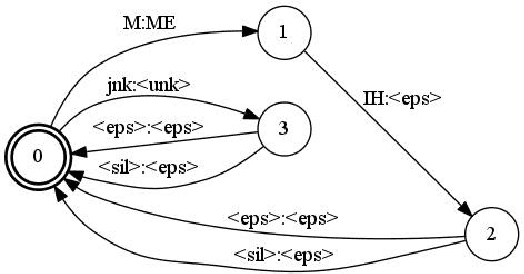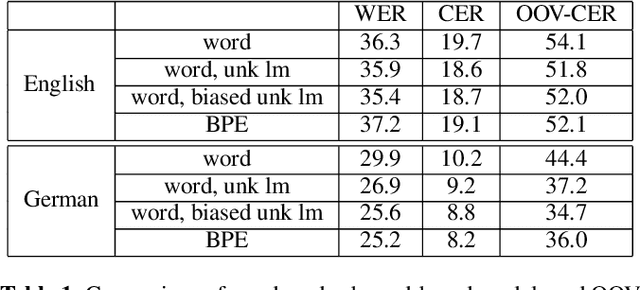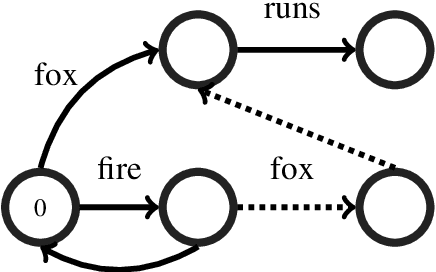Srikanth Madikeri
TokenVerse++: Towards Flexible Multitask Learning with Dynamic Task Activation
Aug 27, 2025Abstract:Token-based multitasking frameworks like TokenVerse require all training utterances to have labels for all tasks, hindering their ability to leverage partially annotated datasets and scale effectively. We propose TokenVerse++, which introduces learnable vectors in the acoustic embedding space of the XLSR-Transducer ASR model for dynamic task activation. This core mechanism enables training with utterances labeled for only a subset of tasks, a key advantage over TokenVerse. We demonstrate this by successfully integrating a dataset with partial labels, specifically for ASR and an additional task, language identification, improving overall performance. TokenVerse++ achieves results on par with or exceeding TokenVerse across multiple tasks, establishing it as a more practical multitask alternative without sacrificing ASR performance.
Better Semi-supervised Learning for Multi-domain ASR Through Incremental Retraining and Data Filtering
Jun 05, 2025Abstract:Fine-tuning pretrained ASR models for specific domains is challenging when labeled data is scarce. But unlabeled audio and labeled data from related domains are often available. We propose an incremental semi-supervised learning pipeline that first integrates a small in-domain labeled set and an auxiliary dataset from a closely related domain, achieving a relative improvement of 4% over no auxiliary data. Filtering based on multi-model consensus or named entity recognition (NER) is then applied to select and iteratively refine pseudo-labels, showing slower performance saturation compared to random selection. Evaluated on the multi-domain Wow call center and Fisher English corpora, it outperforms single-step fine-tuning. Consensus-based filtering outperforms other methods, providing up to 22.3% relative improvement on Wow and 24.8% on Fisher over single-step fine-tuning with random selection. NER is the second-best filter, providing competitive performance at a lower computational cost.
Dialog2Flow: Pre-training Soft-Contrastive Action-Driven Sentence Embeddings for Automatic Dialog Flow Extraction
Oct 24, 2024Abstract:Efficiently deriving structured workflows from unannotated dialogs remains an underexplored and formidable challenge in computational linguistics. Automating this process could significantly accelerate the manual design of workflows in new domains and enable the grounding of large language models in domain-specific flowcharts, enhancing transparency and controllability. In this paper, we introduce Dialog2Flow (D2F) embeddings, which differ from conventional sentence embeddings by mapping utterances to a latent space where they are grouped according to their communicative and informative functions (i.e., the actions they represent). D2F allows for modeling dialogs as continuous trajectories in a latent space with distinct action-related regions. By clustering D2F embeddings, the latent space is quantized, and dialogs can be converted into sequences of region/action IDs, facilitating the extraction of the underlying workflow. To pre-train D2F, we build a comprehensive dataset by unifying twenty task-oriented dialog datasets with normalized per-turn action annotations. We also introduce a novel soft contrastive loss that leverages the semantic information of these actions to guide the representation learning process, showing superior performance compared to standard supervised contrastive loss. Evaluation against various sentence embeddings, including dialog-specific ones, demonstrates that D2F yields superior qualitative and quantitative results across diverse domains.
XLSR-Transducer: Streaming ASR for Self-Supervised Pretrained Models
Jul 05, 2024



Abstract:Self-supervised pretrained models exhibit competitive performance in automatic speech recognition on finetuning, even with limited in-domain supervised data for training. However, popular pretrained models are not suitable for streaming ASR because they are trained with full attention context. In this paper, we introduce XLSR-Transducer, where the XLSR-53 model is used as encoder in transducer setup. Our experiments on the AMI dataset reveal that the XLSR-Transducer achieves 4% absolute WER improvement over Whisper large-v2 and 8% over a Zipformer transducer model trained from scratch.To enable streaming capabilities, we investigate different attention masking patterns in the self-attention computation of transformer layers within the XLSR-53 model. We validate XLSR-Transducer on AMI and 5 languages from CommonVoice under low-resource scenarios. Finally, with the introduction of attention sinks, we reduce the left context by half while achieving a relative 12% improvement in WER.
TokenVerse: Unifying Speech and NLP Tasks via Transducer-based ASR
Jul 05, 2024



Abstract:In traditional conversational intelligence from speech, a cascaded pipeline is used, involving tasks such as voice activity detection, diarization, transcription, and subsequent processing with different NLP models for tasks like semantic endpointing and named entity recognition (NER). Our paper introduces TokenVerse, a single Transducer-based model designed to handle multiple tasks. This is achieved by integrating task-specific tokens into the reference text during ASR model training, streamlining the inference and eliminating the need for separate NLP models. In addition to ASR, we conduct experiments on 3 different tasks: speaker change detection, endpointing, and NER. Our experiments on a public and a private dataset show that the proposed method improves ASR by up to 7.7% in relative WER while outperforming the cascaded pipeline approach in individual task performance. Additionally, we present task transfer learning to a new task within an existing TokenVerse.
Node-weighted Graph Convolutional Network for Depression Detection in Transcribed Clinical Interviews
Jul 03, 2023



Abstract:We propose a simple approach for weighting self-connecting edges in a Graph Convolutional Network (GCN) and show its impact on depression detection from transcribed clinical interviews. To this end, we use a GCN for modeling non-consecutive and long-distance semantics to classify the transcriptions into depressed or control subjects. The proposed method aims to mitigate the limiting assumptions of locality and the equal importance of self-connections vs. edges to neighboring nodes in GCNs, while preserving attractive features such as low computational cost, data agnostic, and interpretability capabilities. We perform an exhaustive evaluation in two benchmark datasets. Results show that our approach consistently outperforms the vanilla GCN model as well as previously reported results, achieving an F1=0.84% on both datasets. Finally, a qualitative analysis illustrates the interpretability capabilities of the proposed approach and its alignment with previous findings in psychology.
Implementing contextual biasing in GPU decoder for online ASR
Jun 23, 2023


Abstract:GPU decoding significantly accelerates the output of ASR predictions. While GPUs are already being used for online ASR decoding, post-processing and rescoring on GPUs have not been properly investigated yet. Rescoring with available contextual information can considerably improve ASR predictions. Previous studies have proven the viability of lattice rescoring in decoding and biasing language model (LM) weights in offline and online CPU scenarios. In real-time GPU decoding, partial recognition hypotheses are produced without lattice generation, which makes the implementation of biasing more complex. The paper proposes and describes an approach to integrate contextual biasing in real-time GPU decoding while exploiting the standard Kaldi GPU decoder. Besides the biasing of partial ASR predictions, our approach also permits dynamic context switching allowing a flexible rescoring per each speech segment directly on GPU. The code is publicly released and tested with open-sourced test sets.
Lessons Learned in ATCO2: 5000 hours of Air Traffic Control Communications for Robust Automatic Speech Recognition and Understanding
May 02, 2023Abstract:Voice communication between air traffic controllers (ATCos) and pilots is critical for ensuring safe and efficient air traffic control (ATC). This task requires high levels of awareness from ATCos and can be tedious and error-prone. Recent attempts have been made to integrate artificial intelligence (AI) into ATC in order to reduce the workload of ATCos. However, the development of data-driven AI systems for ATC demands large-scale annotated datasets, which are currently lacking in the field. This paper explores the lessons learned from the ATCO2 project, a project that aimed to develop a unique platform to collect and preprocess large amounts of ATC data from airspace in real time. Audio and surveillance data were collected from publicly accessible radio frequency channels with VHF receivers owned by a community of volunteers and later uploaded to Opensky Network servers, which can be considered an "unlimited source" of data. In addition, this paper reviews previous work from ATCO2 partners, including (i) robust automatic speech recognition, (ii) natural language processing, (iii) English language identification of ATC communications, and (iv) the integration of surveillance data such as ADS-B. We believe that the pipeline developed during the ATCO2 project, along with the open-sourcing of its data, will encourage research in the ATC field. A sample of the ATCO2 corpus is available on the following website: https://www.atco2.org/data, while the full corpus can be purchased through ELDA at http://catalog.elra.info/en-us/repository/browse/ELRA-S0484. We demonstrated that ATCO2 is an appropriate dataset to develop ASR engines when little or near to no ATC in-domain data is available. For instance, with the CNN-TDNNf kaldi model, we reached the performance of as low as 17.9% and 24.9% WER on public ATC datasets which is 6.6/7.6% better than "out-of-domain" but supervised CNN-TDNNf model.
Effectiveness of Text, Acoustic, and Lattice-based representations in Spoken Language Understanding tasks
Dec 16, 2022Abstract:In this paper, we perform an exhaustive evaluation of different representations to address the intent classification problem in a Spoken Language Understanding (SLU) setup. We benchmark three types of systems to perform the SLU intent detection task: 1) text-based, 2) lattice-based, and a novel 3) multimodal approach. Our work provides a comprehensive analysis of what could be the achievable performance of different state-of-the-art SLU systems under different circumstances, e.g., automatically- vs. manually-generated transcripts. We evaluate the systems on the publicly available SLURP spoken language resource corpus. Our results indicate that using richer forms of Automatic Speech Recognition (ASR) outputs allows SLU systems to improve in comparison to the 1-best setup (4% relative improvement). However, crossmodal approaches, i.e., learning from acoustic and text embeddings, obtains performance similar to the oracle setup, and a relative improvement of 18% over the 1-best configuration. Thus, crossmodal architectures represent a good alternative to overcome the limitations of working purely automatically generated textual data.
A Comparison of Methods for OOV-word Recognition on a New Public Dataset
Jul 16, 2021



Abstract:A common problem for automatic speech recognition systems is how to recognize words that they did not see during training. Currently there is no established method of evaluating different techniques for tackling this problem. We propose using the CommonVoice dataset to create test sets for multiple languages which have a high out-of-vocabulary (OOV) ratio relative to a training set and release a new tool for calculating relevant performance metrics. We then evaluate, within the context of a hybrid ASR system, how much better subword models are at recognizing OOVs, and how much benefit one can get from incorporating OOV-word information into an existing system by modifying WFSTs. Additionally, we propose a new method for modifying a subword-based language model so as to better recognize OOV-words. We showcase very large improvements in OOV-word recognition and make both the data and code available.
 Add to Chrome
Add to Chrome Add to Firefox
Add to Firefox Add to Edge
Add to Edge